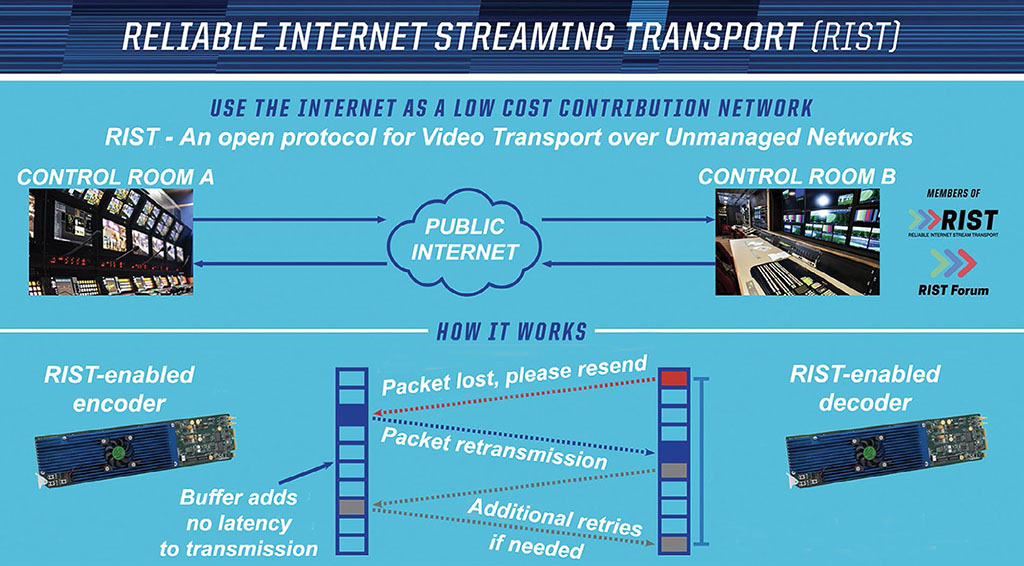RIST Forges Reliable, Secure Internet Connection
ALEXANDRIA, Va.—There is an old saying that goes, “‘Tis impossible to be sure of anything but death and taxes.” I’d like to propose an extension of that quote to include “faster internet speeds,” whether they be wired or wireless.

In the past 20 years at my home, I have literally gone from dial-up speeds that were limited to 28 kbps, to the availability of gigabit Ethernet. Yet for some, pure connection speed is not enough without improved reliability.
Greater reliability and improved security are the goals of the Reliable Internet Stream Transport (RIST) Forum, which has members that include many of the television industry’s best-known companies. Experts at these companies will tell you that the ability to watch streaming 4K content at home is no guarantee that the internet is reliable enough for broadcast origination or contribution.
“For lack of a better word, internet service is ‘bursty’ at best,” said Jacob Kinsey, chief development officer for Cobalt Digital and RIST Forum co-chair. “Internet speed ebbs and flows—sort of like the tides, except internet speed is unpredictable. Because bandwidth access goes up and down with the number of users and the content being accessed, it becomes very important to have a retransmission methodology for video content.”

RIST is one function of the Video Services Forum, which has played an important role in the development of the SMPTE-2110 video over IP transport standard. The international association is comprised of service providers, users and manufacturers that focus on interoperability, quality metrics and education for media networking technologies. The VSF’s activities include:
• Providing forums to identify issues involving the development, deployment, operation and security of media networking technologies;
• Promoting interoperability by contributing towards the development of standards.
The driving force behind RIST is the overall growth of the television industry. There are more content creators on more networks than ever, and this will only continue to increase.
Get the TV Tech Newsletter
The professional video industry's #1 source for news, trends and product and tech information. Sign up below.
“We know live video transport over the internet will grow 15 times or more by 2022, so having a cost-effective solution to transport that video for contribution or distribution applications is essential,” Kinsey said. “RIST offers the key to unlocking video transport interoperability over the internet, and it can be used to transport PTZ control and other communications as well as video and audio signals.”
NATURAL GROWTH?
Won’t the natural growth of faster speeds and technology like 5G be enough to get us the bandwidth and reliability we need?
“The internet is unreliable,” Kinsey said. “Video requires packets of information be delivered in order and in a timely manner. When transporting video over unmanaged networks (as opposed to a private network), reliability is even more difficult to achieve. Reliability is the key to the success of RIST.”
A definition of the term “broadcast quality” is elusive, but it means absolute reliability and the highest quality to many people.

“RIST is designed to deliver broadcast-grade live video transport over any type of connectivity,” said David Griggs, senior product manager for media services at AWS Elemental. “It leverages standards-based quality-of-service [QoS] techniques to ensure that a high-quality, live video stream can be delivered over both managed and unmanaged networks, such as the internet, and at bitrates suitable for professional broadcast applications.”
The potential audiences out there are huge, so the stakes for reliable internet delivery could not be higher.
“More than an estimated billion viewers tuned into coverage of Women’s World Cup this summer, a testament to growing consumer appetite for live video and its importance in modern broadcast programming,” Griggs said. “Whether delivering a premium live sporting event or 24/7 linear service, ensuring reliable, high quality video distribution is essential for customers who want to deliver great viewer experiences.”
OPEN STANDARD
One of the driving forces behind the RIST Forum is interoperability based on an open standard, which is the reason why the RIST Forum is populated by manufacturers. There are some proprietary and semi-proprietary networking protocols targeted at the broadcast industry, and RIST promises to replace them with an open standard along the lines of RS422.

“In the past, internet transport content distribution models were manufacturer-specific and did not allow for implementation without requiring uniform deployment of identical-brand hardware or software at each location,” said Paul Atwell, president of Media Transport Solutions and a RIST Forum member. “RIST allows for the transport and exchange of content by applying a uniform set of existing practices manufacturers can implement in order to allow interoperability between unrelated sending and receiving devices.”
Atwell said that RIST will let customers keep existing hardware (encoders, decoders, multiplexers, integrated receivers, etc.), without requiring a wholesale replacement or writing off a previous capital expense.
Although the ever-increasing internet bandwidth to the home is fine for watching streaming content in living rooms, Atwell and others pointed out that occasional lags and dropouts seen at home are unacceptable to content creators, distributors and broadcasters.
“Occasional bandwidth congestion or brief loss of service is somewhat acceptable or even anticipated by the average user of the internet,” Atwell said. “For the delivery of high-quality source material, such as HD cameras located at a remote sporting event or returning broadcast content for network distribution, interruptions in the contribution stream are unacceptable.”
One relatively low-cost way that RIST plans to build in more reliability is to incorporate reliable bonding of multiple IP connections to sustain the required transport bandwidth. Not only does this provide a wider pipe when all the circuits are working, it allows for failure of one or more circuits without killing the entire feed.
MORE EFFICIENT COMPRESSION
Another way to improve the reliability of contribution feeds is to use more efficient compression of the video signal. Since compressed video is sent as packets, more compression means that fewer packets need to be sent—however, the loss of a packet results in a greater breakup of the transmitted signal.
Still, the inherent improvement in reliability by sending less data (i.e., using more compression) is significant.
“Applying RIST to transport streams with greater compression increases reliable delivery of valuable payload packets, plus the added benefit of a reduction in allocated bandwidth,” Atwell said.
RIST technical recommendations will continue to evolve as Forum members weigh in and incorporate preliminary recommendations into their hardware. Meanwhile, manufacturers and other interested parties will continue to refine the standards and practices through the Video Services Forum.
What has happened so far in the industry is that a couple of companies recognized the benefits of IT infrastructure early on and developed proprietary network devices specifically for broadcast transport. These worked great within a facility, and didn’t really need to connect to the wider world since commercially available networks did not have the sort of bandwidth and reliability required for content distributors. Still, these were proprietary solutions that meant you had to get a bunch of “Brand X” boxes to make everything work.
The RIST Forum is focusing on building that reliability into each connected component, and also adapting them to work with the wider internet with increased reliability. And since the content is valuable, encryption should be built in from the start.
RIST was established in March 2019 with 21 founding members, which has since grown to 36, according to RIST Forum co-chair Kinsey.
“Our industry association has a presence at every major trade show, and we’ve sponsored programs at NAB and IBC. One of the concerns with using the open internet for video transport is security, so RIST has added encryption and VPN tunneling, which was part of our RIST Main Profile demo at IBC in September. Our goal is to make IP transport over the internet as ubiquitous and reliable as SDI cabling within a facility.”
For more information, visit www.rist.tv.
Bob Kovacs is the former Technology Editor for TV Tech and editor of Government Video. He is a long-time video engineer and writer, who now works as a video producer for a government agency. In 2020, Kovacs won several awards as the editor and co-producer of the short film "Rendezvous."

